
* In the early 1960s, the Bell Helicopter company began a program to develop a light turboshaft-powered helicopter, which after a few zigs and zags emerged as the "Model 206 JetRanger". The JetRanger would prove a popular machine, both in civil and military service, and prove highly extendable, with derivatives still being introduced in the 21st century. This document provides a history and description of the JetRanger family. A list of illustration credits is included at the end.
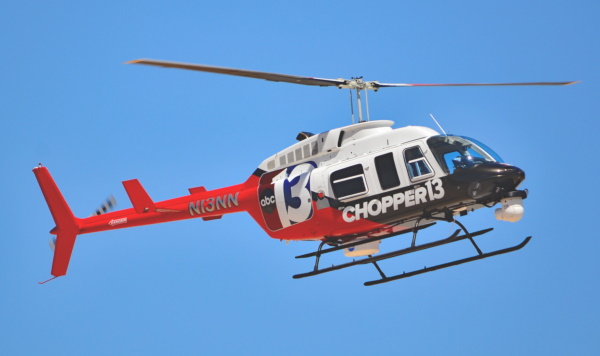
* In 1960, the US Army initiated a "Light Observation Helicopter (LOH)" competition to acquire a modern replacement for the Bell Model 47 / H-13 and other light piston helicopters in the scout and utility role. A dozen companies submitted proposals, with Bell offering the "OH-4A", Hiller the "OH-5A", and Hughes the "OH-6A". The Army ordered five prototypes of each, all to be powered by a single Allison T63 turboshaft engine.
The OH-4A reflected some design influence from the classic Bell Model 47, though it differed in featuring a full fuselage and of course turboshaft propulsion. The OH-4A retained the classic Bell main rotor configuration, with twin blades and a crossways "teeter bar". The US Navy was managing the program for the Army, and quickly rejected the OH-4A: it was designed almost strictly for the observation role, with extensive glazing, but didn't have the carriage capability to really fill the utility role.
The Hughes OH-6A was also rejected; it was notably agile, but judged too lightly built for combat use. That left the Hiller OH-5A as the winner -- if only in principle. While the Navy had concluded the OH-5A was the best machine for the requirement, the Army had other ideas, partly because Howard Hughes, the boss of Hughes Aircraft, was pulling out all the stops to get the deal. There were stories of "irregularities" in Hughes' lobbying; such tales are difficult to prove -- but among the list of accusations, the claim that Hughes had recklessly underbid to win the contract would be clearly demonstrated by later events.
* Bell didn't simply discard the OH-4A after losing the LOH contract, and in fact took the rejection to heart, substantially updating the design with a new, wider, and much sleeker fuselage. The usual reaction to the appearance of the OH-4A was that it was ugly, and while appearance didn't matter too much to the military, style was definitely a consideration for civil sales. A prototype of the resulting "Model 206A JetRanger" -- the name reflecting Bell's popular Model 47J Ranger piston-powered helicopter -- took to the air for the first time on 10 January 1966. The JetRanger obtained civil certification in October 1966, with production deliveries before the year was out. It was second-sourced by Agusta in Italy as the "AB 206A", with Agusta building subsequent subvariants of the JetRanger.
The Model 206A was of conventional main-tail rotor configuration, with a two-blade main rotor -- without the old Bell teeter bar, the company having refined their rotor design to eliminate it -- and a two-blade tail rotor. The JetRanger was powered by a single Allison 250-C18A turboshaft engine with 236 kW (317 SHP), the Allison 250 being a commercial version of the T63. The Model 206A had skid landing gear, plus seats for five, consisting of two single seats in front and three seats across in back. There were two forward-hinged doors on each side. There was a baggage compartment behind the passenger compartment, with the door on the left. Pontoons or inflatable floats were optional, as were dual controls and an external belly sling hook with a maximum load capacity of 545 kilograms (1,200 pounds).
___________________________________________________________________
BELL MODEL 206A:
___________________________________________________________________
main rotor diameter:
10.16 meters (33 feet 4 inches)
tail rotor diameter:
1.57 meters (5 feet 2 inches)
fuselage length:
9.5 meters (31 feet 2 inches)
footprint length:
11.82 meters (38 feet 10 inches)
height:
2.91 meters (9 feet 6 inches)
empty weight:
638 kilograms (1,407 pounds)
max loaded weight:
1,360 kilograms (3,000 pounds)
maximum cruise speed:
195 KPH (120 MPH / 105 KT)
service ceiling:
6,100 meters (20,000 feet)
range:
480 kilometers (300 MI / 260 NMI)
___________________________________________________________________
* Commercial sales of the JetRanger were brisk, and Bell managed to land a US military order right away. The US Navy was in need of a training helicopter and wanted to obtain an off-the-shelf solution; the Bell 206A looked like the right item, and at the end of January 1968 the Navy awarded Bell a contract for 40 "TH-57 SeaRanger" helicopters. They were almost stock Model 206As, aside from dual controls and some military avionics.
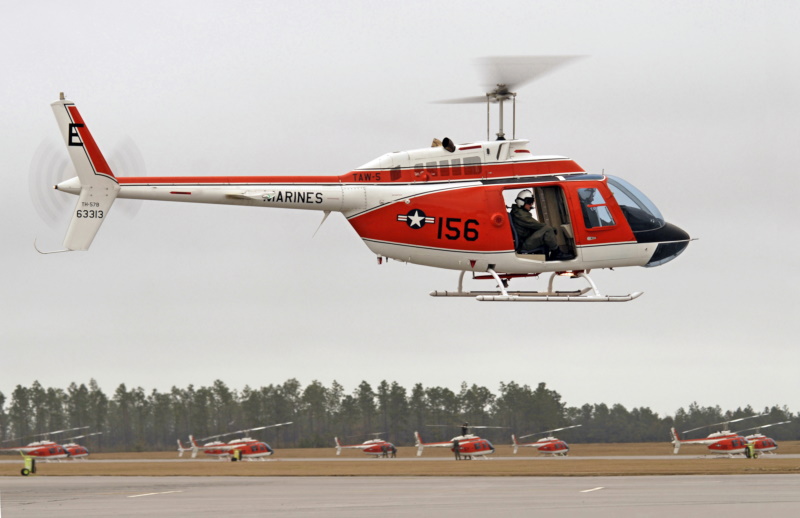
That turned out to be just a warmup. After obtaining the Hughes OH-6A, the US government had become increasingly aware that Howard Hughes had overpromised on their product, with deliveries falling far behind schedule and Hughes attempting to jack up the price. Congress got involved; heads rolled; the Hughes contract was cut short; and in 1967, the Army restarted the LOH competition. Hiller officials -- by that time, the company had become part of Fairchild -- had found the first competition a very disagreeable exercise and refused to participate in the second round, even though the odds were good that they would win. Their loss was Bell's gain, with the Army selecting a militarized Model 206A, the "OH-58A Kiowa", on 8 March 1968. Initial service deliveries were in the following year, 1969.
The OH-58A differed from the Model 206A primarily in featuring a wider main rotor -- 10.77 meters versus 10.16 meters (35 feet 4 inches versus 33 feet 4 inches) and an Allison T63-A-700 turboshaft engine with 235 kW (315 SHP). Of course the OH-58A featured militarized avionics, as well as a modified layout, with seats for two and the rest of the cabin reserved for cargo carriage. Deliveries began in May 1969, with the Kiowa promptly going into combat in Vietnam. A total of 2,200 production OH-58As was delivered into 1973. Apparently some were ultimately sold off to civilian users with minor alterations under the designation of "Model 206A-1".
The Canadian Armed Forces obtained 74 Kiowas from 1971 as the "COH-58A", later changed to "CH-136". These machines were actually diverted from US Army contracts, with the Army issuing a new contract to make up the shortfall. A dozen Kiowas were delivered to Austria in 1976; they were basically OH-58As but featured some minor changes, and were designated "OH-58B".
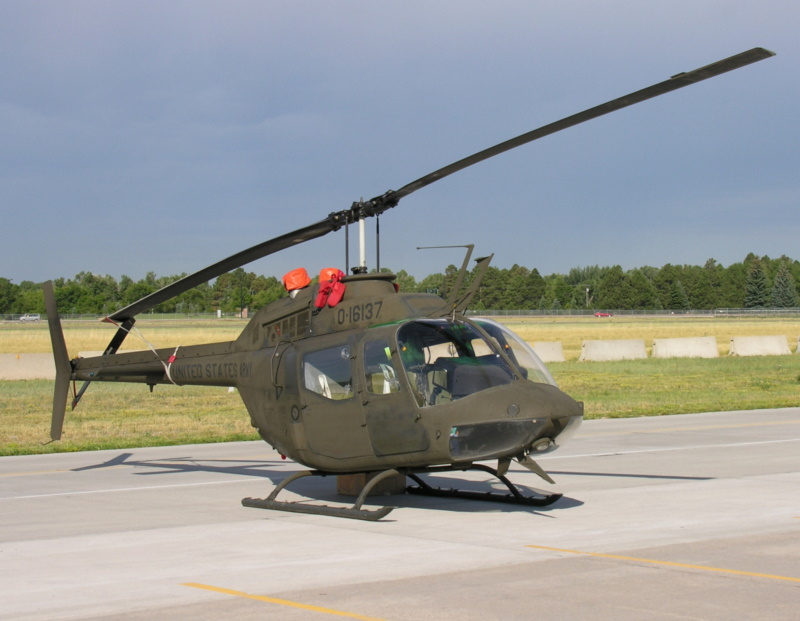
In 1976, under Army direction Bell upgraded an OH-58A with flat "no glint" canopy panels, an improved cockpit compatible with night vision goggles (NVGs), an AN/APR-39 radar warning receiver (RWR), exhaust thermal signature suppressors, and a more powerful Allison T63-A-720 engine with 315 kW (420 SHP). The exercise going well, two more prototype conversions were performed, and then from March 1978 Bell upgraded a total of 425 OH-58As to the new configuration, with the upgraded rotorcraft designated "OH-58C". 150 more OH-58As in Army service in West Germany were upgraded to OH-58C specification by Israel Aircraft Industries (IAI).
BACK_TO_TOP* In early 1971, Bell began shipping the new "Model 206B JetRanger II", which replaced the Model 206A on the production line. The primary difference was fit of an uprated Allison 250-C20 turboshaft engine with 300 kW (400 SHP), as well as an update of the tee-style cockpit dashboard to a rectangular format. The changes were minor, and so it was easy to update a Model 206A to Model 206B spec -- with such machines at least informally known by the designation of "Model 206A/B".
The uprated Allison 250-C20 turboshaft was very welcome; the original 250-C18A left the machine underpowered, ensuring that the engine was run near its ratings on a regular basis, and resulting in relatively frequent engine overhauls. The Australian armed forces acquired the "Model 206B-1 Kiowa" for the observation and utility role, with 12 supplied directly by Bell and 44 assembled by Commonwealth Aircraft Corporation in Australia. They were designated "CA-32" in Aussie service. The last of them were retired in 2018.
* The JetRanger II was similarly followed in 1977 by the "Model 206B JetRanger III", the main improvement again being an uprated powerplant, in the form of the Allison 250-C20B, with 315 kW (420 SHP). The series was then enhanced to the "Model 206B-3 JetRanger III", with an Allison 250-C20J powerplant providing the same power ratings but technical improvements, as well as a tail rotor with greater span. Earlier B-models could be upgraded to the B-3 configuration, with such upgraded machines designated "Model 206B-2".

New options were provided for the JetRanger product line in its evolution from the Model 206A, with options for the Model 206B-3 adding:
Of course a belly sling hook could still be added, with the load capacity increased to 680 kilograms (1,500 pounds).
___________________________________________________________________
BELL MODEL 206B-3 JETRANGER III:
___________________________________________________________________
main rotor diameter:
10.16 meters (33 feet 4 inches)
tail rotor diameter:
1.65 meters (5 feet 5 inches)
fuselage length:
9.5 meters (31 feet 2 inches)
footprint length:
11.96 meters (38 feet 10 inches)
height, with standard low skids:
2.91 meters (9 feet 6 inches)
empty weight:
760 kilograms (1,675 pounds)
max loaded weight:
1,520 kilograms (3,350 pounds)
maximum cruise speed:
215 KPH (140 MPH / 120 KT)
service ceiling:
6,100 meters (20,000 feet)
range:
730 kilometers (455 MI / 375 NMI)
___________________________________________________________________
* The last Bell 206B-3 was rolled out in 2010, with a total of 4,491 Model 206A/B helicopters built. That total did not include specifically military production.
In the mid-1980s, following up the purchase of the original TH-57A SeaRanger, the US Navy obtained another batch of helicopter trainers based on the JetRanger III, in the form of the "TH-57B / TH-57C SeaRanger" -- both the TH-57B and TH-57C featuring dual controls, but the TH-57C adding kit for instrument flight rules (IFR) or "blind flight" training. The Navy obtained 51 TH-57Bs and 89 TH-57Cs.
In 2007, the Navy initiated a program with L3 Communications to update 128 surviving TH-57Bs and TH-57Cs to the "TH-57D Common Standard", with the upgraded aircraft to feature:
All TH-57Ds were redelivered by 2014. The program was intended to provide flight trainees with a training helicopter much more representative of the rotorcraft they will fly in service. The upgrade was expected to pay itself back fairly quickly by eliminating the need for two training variants, with a resulting simplification in the training curriculum and trimming of maintenance costs -- particularly through reduction of engine wear via the stick-shaker system.
As the upgrade suggests, the Navy really liked the SeaRanger. In the early 1990s, the US Army was influenced by the Navy experience to obtain the Model 206B-3 for the training role, with the machine designated the "TH-67A Creek". The Army acquired a total of 183 TH-67As, with initial delivery in 1993; part of the buy was of machines configured for IFR training, with the designation "TH-67A+".
In 2014, the US Army decided to get rid of the TH-67A, replacing it in the training role with Airbus UH-72 Lakotas, configured as dual-control trainers. That simplified operations and logistics, the Lakota being the Army's standard light utility helicopter. The TH-67As were passed on to other services, civilian organizations, commercial users, and Colombia -- with other Latin states to obtain them as well. The last TH-67s were out of Army training service by early 2021, though the service retained about 20 of them for a time to support field training exercises. The SeaRanger was retired in 2023, being replaced by the Leonardo TH-117.
* Sources mention that the Chilean Navy obtained a "Model 206AS" variant -- being counted as part of civil production totals -- which has been described as carrying torpedoes or other armament for maritime combat. However, photos didn't show any significant customizations other than inflatable flotation packs, and so the specific configuration of these machines is unclear.
BACK_TO_TOP* While Bell was improving the Model 206B, the company was also working on a "stretched" variant, which emerged as the "Model 206L LongRanger". Initial flight of a prototype was on 11 September 1974. The LongRanger featured a fuselage stretch of 63 centimeters (25 inches) to fit two crew seats and five passenger seats -- the additional two seats being single seats set behind the crew seats, and facing backwards. The increase in length led to the introduction of a small third window between the two original windows, providing a distinctive recognition feature for the LongRanger.
On the right side of the machine, the middle window was inset in a fixed section between the front and rear forward-hinged doors. On the left side, the middle window was inset into a forward-hinged door section -- with the rear door forward-hinged on it in turn. This somewhat unusual "double hinged" door arrangement allowed the left rear door to be opened as normal, or allowed both the middle and rear left doors to be opened as a single wide door -- it's hard to think many found it a particularly elegant arrangement. The LongRanger was powered by the same Allison 250-C20B turboshaft as the original JetRanger III, with 300 kW (400 SHP), and was fitted with an improved rotor system. Agusta also license-built the LongRanger, though it is unclear if the company actually built all of the LongRanger's subvariants.
* In 1978, Bell production moved on to the "Model 206L-1 LongRanger II", the primary distinction of this variant being fit of the more powerful Allison 250-C28B turboshaft providing 365 kW (490 SHP), as well as a new transmission system to handle the more powerful engine. A "Model 206L-2" was sold in parallel, the difference being a derated engine. Bell built a demonstrator for a militarized variant of the LongRanger II named the "TexasRanger", but there were no sales; however, it does appear that a few military forces obtained Model 206L machines in near-civil configurations.
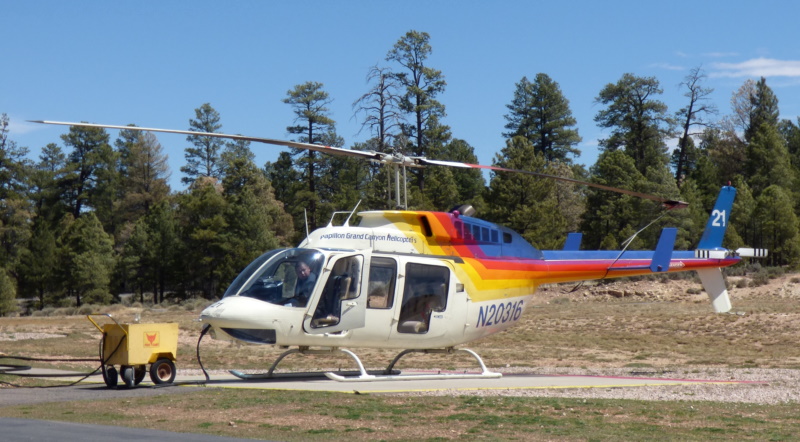
The Model 206L-1 LongRanger III was followed in turn in 1981 by the "Model 206L-3 LongRanger III", which was fitted with a still more powerful Allison 250-C30P turboshaft providing 485 kW (650 SHP). In that same year, Bell established Bell Textron Canada at Mirabel, Quebec, as a production facility; from 1986 all Bell civil helicopters were built by the Canadian plant. In 1992, the new plant introduced the "Model 206L-4 LongRanger IV", with an uprated transmission and seven passenger seats.
Upgrades to Model 206L-4 were available for the Model 206L-1 and 206L-3, with the updated machines designated "Model 206L-1+" and "Model 206L-3+". Options for the Model 206L-4 were much the same as they were for the Model 206B-3; sling loads could be up to 900 kilograms (2,000 pounds).
___________________________________________________________________
BELL MODEL 206L-4 LONGRANGER IV:
___________________________________________________________________
main rotor diameter:
10.28 meters (37 feet)
tail rotor diameter:
1.65 meters (5 feet 5 inches)
fuselage length:
9.82 meters (32 feet 4 inches)
footprint length:
12.96 meters (42 feet 6 inches)
height (rotor head):
3.04 meters (10 feet)
empty weight:
760 kilograms (1,675 pounds)
max loaded weight:
2,065 kilograms (4,450 pounds)
maximum cruise speed:
215 KPH (140 MPH / 120 KT)
service ceiling:
3,660 meters (12,000 feet)
range:
600 kilometers (375 MI / 325 NMI)
___________________________________________________________________
The last LongRanger was rolled out in 2017, after more than 3,800 were built.
* In the mid-1980s, Bell worked on a twin-engine version of the LongRanger, the "Model 400 TwinRanger", of which more is said later, but did not go on to production of this variant. However, in the early 1990s an outside firm, Tridair Helicopters, began to perform "Gemini ST" conversions of LongRangers to a twin-engine format. Bell reconsidered the idea of a twin LongRanger and in early 1994 introduced the "Model 206LT TwinRanger", powered by twin Allison 250-C20R turboshafts with 335 kW (450 SHP) each. It retained the two-bladed rotor of the LongRanger. It did not prove successful, with only a handful of machines built, and production terminated in 1997.
One particularly unusual variant of the LongRanger was built by Cardoen SA of Chile, with two imported commercial LongRangers converted from 1988 to the "CB 206L-3" configuration. These machines had a modified fuselage with a narrower cross-section, flat-plate canopy panels, and cable cutters; they were designed as multirole combat machines, capable of being fitted with side stores pylons for gun or rocket pods. The first of the two flew in late 1989; one was sent to the US for qualification, but due to suspicions that the Iraqis were backing the exercise the Americans refused to touch it, and the program died out.
BACK_TO_TOP* In September 1981, Bell won a contract from the US Army for the "Army Helicopter Improvement Program (AHIP)", which specified a new scout helicopter with modern combat avionics. The competition, incidentally, was the Hughes 500, a refined descendant of the Hughes OH-6; it was something of "deja vu all over again".
The Bell design, originally known as the "OH-58D Aeroscout", was an update of the OH-58A/C with an Allison T703-AD-720 turboshaft with 485 kW (650 SHP), driving a four-bladed composite main rotor with a modernized rotor hub, and fitted with a prominent mast-mounted sight (MMS), coupled to a cockpit control and display system. Early development work was conducted from March 1983 using a LongRanger III fitted with the four-bladed rotor and an Allison 250-C30 turboshaft engine, this machine being designated the "Model 406LM". Initial flight of the first of five OH-58D prototypes was on 6 October 1983, leading to first service deliveries in March 1986. The prototypes and all the US Army OH-58Ds were conversions of OH-58A/Cs. It is unclear how many OH-58Ds the Army originally obtained, sources suggesting the number was in the range from 300 to 500.
The OH-58D featured cable cutter blades and the MMS, which was in the configuration of a ball mounted high over the top of the rotor hub to allow the crew to keep an eye on things while flying under the treeline. The ball contained a TV imager and forward-looking infrared (FLIR) imager, along with a laser rangefinder / target designator. It also contained an automatic "Optical Boresight System (OBS)" that could even align the imagers and the laser system in flight. The MMS featured an anti-vibration mounting system, with the ball able to rotate all the way from front to rear in the horizontal plane and +/-30 degrees in the vertical plane. The cockpit featured a display and control system for the MMS.
The OH-58D was not originally armed, its mission being to find and designate targets for strike assets, particularly the AH-64 Apache helicopter gunship. However, in 1987, when the US Navy was escorting oil tankers in the Persian Gulf under Operation EARNEST WILL to prevent attacks by the Iranians, the Army initiated a fast-track program codenamed PRIME CHANCE to fit a light armament load to the OH-58D, with a batch of 15 machines quickly kitted up with a stores pylon on each side of the rotorcraft. Army aircrews were trained to operate off naval vessels and served as part of the Persian Gulf convoy escort.
The result was designated the "OH-58D (Armed)", but it was also informally referred to as the "PRIME CHANCE OH-58D" or the "AH-58D". Typical stores carried on each pylon included two Hellfire anti-armor missiles; a seven-round 70-millimeter unguided rocket pod, with a capacity of 7 missiles; a General Electric (GE) 7.62-millimeter (0.30-caliber) Gatling Minigun; a 12.7-millimeter (0.50-caliber) Browning machine gun; or twin Stinger air-to-air missiles (AAM).
Photos rarely show any weapons fit but Hellfires or unguided rocket pods, but it appears that the machines assigned to the convoy escort flew in pairs, with one fitted with twin Hellfires and a machine gun, the other with an unguided rocket pod and two Stingers. It seems they fired quite a few shots in anger in the course of EARNEST WILL, but the Pentagon did not see fit to say much about the matter. The official line was to downplay the fact that the Americans and Iranians were shooting at each other.
___________________________________________________________________
BELL OH-58D KIOWA WARRIOR:
___________________________________________________________________
main rotor diameter:
10.67 meters (35 feet)
tail rotor diameter:
1.65 meters (5 feet 5 inches)
fuselage length:
10.48 meters (34 feet 5 inches)
footprint length:
12.85 meters (42 feet 2 inches)
height:
3.93 meters (12 feet 11 inches)
empty weight:
1,380 kilograms (3,045 pounds)
max loaded weight:
2,040 kilograms (4,500 pounds)
maximum cruise speed:
225 KPH (140 MPH / 120 KT)
service ceiling:
3,660 meters (12,000 feet)
range:
465 kilometers (290 MI / 250 NMI)
___________________________________________________________________
* The PRIME CHANCE effort working out well, in 1989 the Army decided to upgrade most of the OH-58D fleet to the armed configuration -- with some slight improvements, such as the addition of engine exhaust diffusers to make the rotorcraft less of a target for heat-seeking missiles. The "Armed OH-58D" became known as the "Kiowa Warrior", with 411 conversions to 1999. The Kiowa Warrior served in Operation JUST CAUSE, the US occupation of Panama, in 1989; Operation DESERT SHIELD / DESERT STORM, the First Gulf War, in 1991; Operation RESTORE HOPE, the ill-fated US peace-keeping mission to Somalia, in 1993; and Operation UPHOLD DEMOCRACY, the US peace-keeping mission to Haiti, in 1994.
Even before the final deliveries of OH-58Ds, upgrades were being performed, to part or all of the fleet:
A batch of 18 OH-58Ds was also reconfigured with "stealth" features, including a reprofiled and longer nose plus a coating on the windshield, apparently to prevent radar pulses from entering the cockpit, and named the "Optimized Aircraft (OH-58D OA)" -- apparently it was also known as the "OH-58X" early on. First flight was in 1990. Bell configured one OH-58D with similar features and other modern updated kit as the unhelpfully-named "OH-58D Variant" to demonstrate possible new features for the OH-58D.
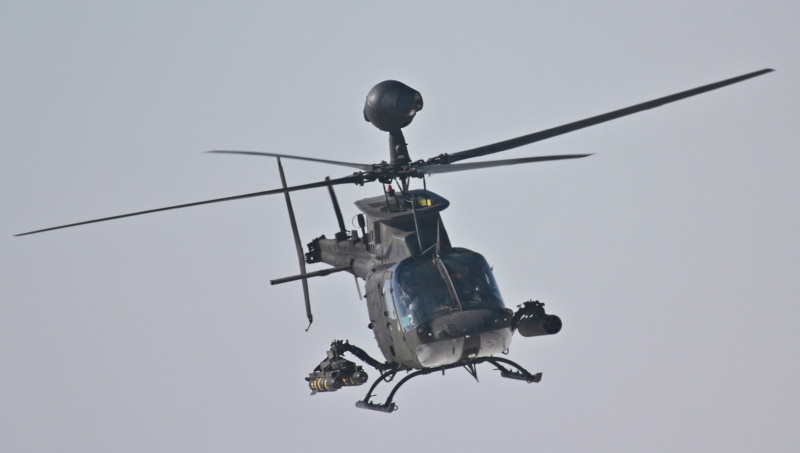
* The only export customer for the OH-58D was Taiwan, which bought a total of 26, with initial deliveries in 1993. However, Bell also offered for the export market a cheaper "detuned" version of the OH-58D, the "Model 406CS", differing most visibly in swapping out the mast-mounted sight for a rooftop-mounted SAAB-Emerson HeliTOW sight for TOW wire-guided anti-tank missiles. Saudi Arabia was the sole customer, with 15 machines delivered from 1990.
The OH-58D was heavily tasked in Operation ENDURING FREEDOM, the US invasion of Afghanistan, from 2001; and Operation IRAQI FREEDOM, the US invasion of Iraq, from 2003. Operational attrition had winnowed the fleet down to 326 machines; to build it back up to designated strength of 368 machines, Bell was awarded a contract to upgrade OH-58A/C machines to OH-58D specification, with the first upgraded helicopter delivered in 2012.
Although at least 23 replacement upgrades were performed, with the program also to include new-build machines, it is unclear the replacement program was ever completed, since the OH-58 has now been phased out of US Army service. There was a push to replace the OH-58D with an improved machine, the "ARH-70" -- see below -- but that program fell through. Upgrades were implemented to keep the Kiowas flying, with work towards a renewed "OH-58F", the first being rolled out in late 2012. The plan was to convert all OH-58Ds to OH-58F spec, but in 2014 the decision was made, in light of funding cuts, to scrap the OH-58D, and all work on the OH-58F was halted. The OH-58D was formally retired from US Army service in the spring of 2017.
The OH-58 fleet -- including OH-58A, OH-58C, and OH-58D machines -- has been transferred to other users, with 24 OH-58Ds sold to Tunisia, 16 sold to Croatia, and 70 sold to Greece; being armed helicopters, they couldn't be passed on to commercial use. As far as a replacement for the OH-58D goes, as discussed later, it would never happen.
BACK_TO_TOP* Having developed the four-bladed rotor for the Kiowa, of course the Bell company thought to leverage it into civilian helicopter designs. The first effort was the "Model 400 TwinRanger", mentioned above, which performed its first flight on 30 June 1984. It was based on the LongRanger but, as its name implied, had twin engines, in the form of dual Allison 250-C20R turboshafts, as well as the four-bladed rotor; it also added a tail rotor ring, apparently to improve safety. Three more Model 400 preproduction machines followed, but there were no orders and the program was abandoned. For whatever reasons, the tail rotor ring concept appears to have died with it. There was consideration of a stretched "Model 440" featuring composite construction, but it never got out of the paper stage.
* There matters stood for almost a decade. When Bell returned to development of JetRanger derivatives, the company worked roughly in parallel on an improved single-engine machine, and to develop a satisfactory twin-engine machine. Work on the single-engine track led to the "Model 407". In 1993, Bell modified a Model 206L-3 LongRanger with the OH-58D main and tail rotors as a demonstrator, with the machine performing its first flight on 21 April 1994. All going well, the first of two prototypes performed its initial flight on 29 June 1995, leading to flight of a production machine in November, with certifications and deliveries to customers in early 1996.
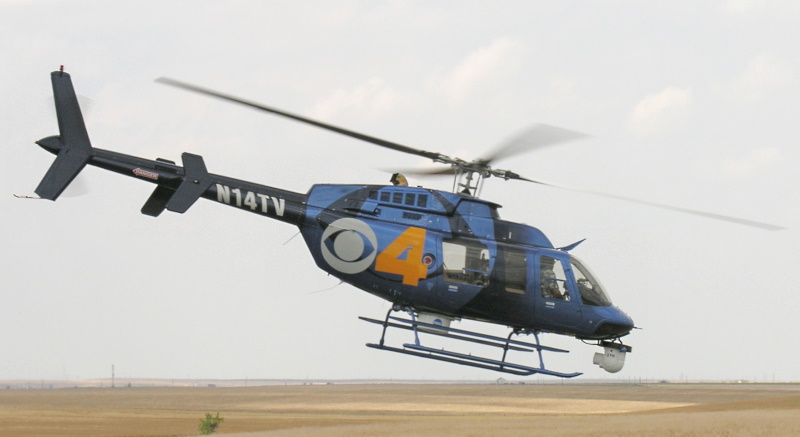
The Model 407 looked much like the LongRanger except for the four-blade composite rotor, but it also had a revised fuselage featuring width increased by 18 centimeters (8 inches) -- the demonstrator was mocked up with padding to simulate the wider fuselage -- and larger passenger windows. The asymmetric door scheme of the LongRanger was retained. The Model 407 was powered by a single Rolls-Royce / Allison 250-C47 turboshaft with 520 kW (700 SHP). Apparently there was some consideration of using the tail rotor ring with the Model 407, but it didn't happen. Options were much like those of other contemporary derivatives of the JetRanger, with the Model 407 having a maximum sling load of 1,200 kilograms (2,646 pounds).
___________________________________________________________________
BELL MODEL 407:
___________________________________________________________________
main rotor diameter:
10.66 meters (35 feet)
tail rotor diameter:
1.65 meters (5 feet 5 inches)
fuselage length:
10.57 meters (34 feet 8 inches)
footprint length:
12.74 meters (41 feet 9 inches)
height (tailfin):
3.1 meters (10 feet 2 inches)
empty equipped weight:
1,215 kilograms (2,675 pounds)
max loaded weight (with sling load):
2,270 kilograms (6,000 pounds)
maximum cruise speed:
245 KPH (150 MPH / 130 KT)
service ceiling:
3,660 meters (12,000 feet)
range:
610 kilometers (380 MI / 330 NMI)
___________________________________________________________________
The Model 407 proved very popular, with Bell reporting the delivery of the 1,000th machine in the series in 2010, to Shin-Nihon Helicopter of Japan. In 2011, Bell introduced two new Model 407 models:
A combat version of the 407GX, the "Model 407GT", was introduced in 2013, with a chin day-night imager / laser designator turret, and stub-mounted weapons loads. From 2015, Northstar Aviation of the United Arab Emirates also offered a combat version of the 407GX, the "407 Multi-Role Helicopter (MRH)", to act as a transport, scout, or gunship, with UAE forces obtaining several dozen of them.
A refined follow-on of the 407GX, the "Model 407GXP", was introduced in 2015, featuring incremental improvements in payload and performance, plus refined cockpit avionics, including a speech recognition system. A further improved variant, the "Model 407GXi", was introduced in 2018, with Garmin G1000H avionics featuring touchscreens, updated interiors, and a Rolls-Royce M250-C47E/4 turboshaft engine with dual FADEC. The updated engine provided a 4% improvement in range and fuel economy.
A next-generation combat version, the "407M", was introduced in 2022, featuring comprehensively updated mission avionics and compatibility with new munitions -- such as the Advanced Precision-Kill Weapons System, a laser-guided 70-millimeter rocket. Sources also mention an armed "407AH" for border patrol and other civil security forces.
* In 2005, Bell won a US Army contract for an "Armed Reconnaissance Helicopter (ARH)" to replace the OH-58D Kiowa Warrior. The "ARH-70", as it was designated, featured the airframe of the Model 407 but the tail of the Model 427 -- discussed later -- plus a new Honeywell HTS900 turboshaft engine providing 690 kW (925 SHP). The "Arapaho", as it was informally named, was to carry a pilot and observer / gunner, along with advanced sensors and defensive countermeasures. Lockheed Martin was actually the prime contractor, providing integration of avionics and combat systems.
The Army wanted to obtain 368 machines, specifying a unit cost of $6 million USD. Some of the other bidders in the original competition dismissed that pricetag as "unrealistic", which was borne out in 2008 when cost overruns forced the cancellation of the program. The Army restarted the ARH competition as the "Armed Aerial Scout (AAS)" effort, but that went into limbo too, while the decision was made to kill off the OH-58. The AAS effort was then revived -- to go through several variations, then being killed off for good in 2024. Combat in the Ukraine War from 2022 indicated that the crewed scout helicopter was a thing of the past, and the future belonged to drones.
* Bell also considered a civilianized version of the ARH-70, the "Model 417", but it was a nonstarter. In some compensation for the collapse of the ARH program, in 2009 Bell received a contract to supply 24 Model 407GX machines to the Iraqi Air Force, with an option for 26 more. The machines were modified by NorthStar of Abu Dhabi into a military "Multi-Role Helicopter (MRH)" configuration, featuring:
A typical weapons load would be two Miniguns and two 9-round rocket pods. It appears that the United Arab Emirates also has obtained 30 or more MRH machines, with some having seen combat in Yemen.
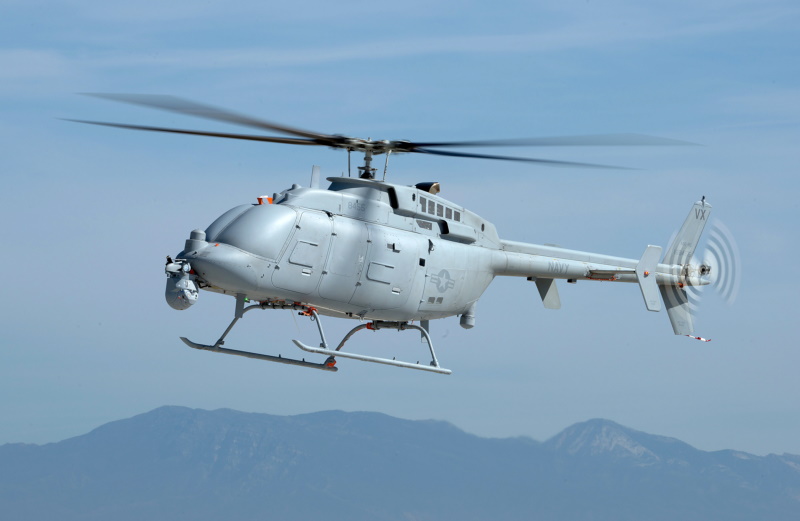
In addition, Bell worked with Northrop Grumman on a drone derivative of the Model 407 for military use, with a demonstrator named the "Fire-X" performing its initial flight in late 2010. The US Navy had been working on the "MQ-8B Fire Scout" drone helicopter, based on the Schweizer 330SP helicopter, but decided it wasn't big enough.
The Navy has acquired a production version of the Fire-X as the "MQ-8C", the base designation remaining the same because the Fire-X leverages off Fire Scout software and control systems. The MQ-8C had, along with drone avionics and sensor system, additional fuel tanks and an uprated Rolls-Royce M250-C47E turboshaft.
Initial flight of the first full prototype was on 31 October 2014, with deliveries of production machines for service evaluation the next year, and introduction of the MQ-8C to operational service in 2019. Along with surface surveillance, the MQ-8C is also intended to serve in the anti-submarine warfare and mine-hunting roles. A Link-16 datalink system was introduced for the MQ-8C in 2019, followed by the advanced AN/ZPY-8 active-array radar in 2020. Bell has been working on fitting the Fire Scout with a combat systems suite for antisubmarine warfare.
As far as the HTS900 engine goes, Honeywell worked with Eagle Copters of Calgary, Alberta, Canada for after-market upgrades of Model 407s with the new engine. The updated machines were named "Eagle 407 HP".
BACK_TO_TOP* As for a twin-engine JetRanger derivative, in the wake of the Model 400 Bell considered a "Model 407T" with twin Allison 250-C22B engines, but decided that more redesign was needed to develop a twin machine that would be acceptable to the customer base.
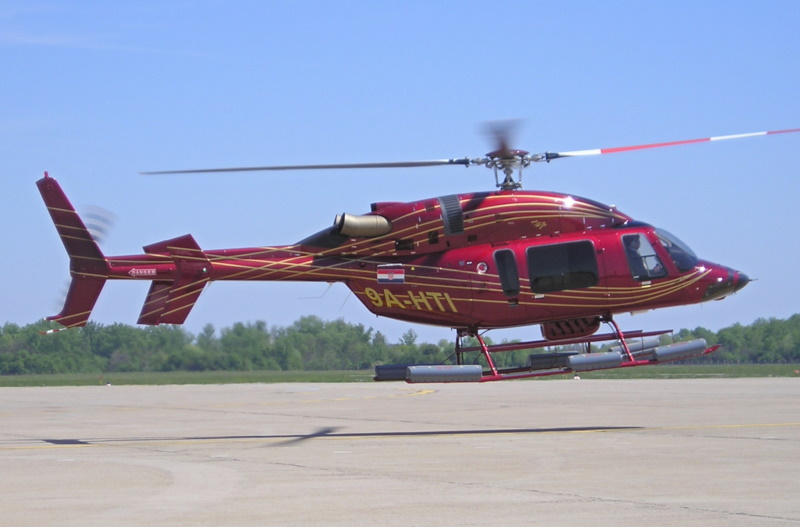
After further work, the company introduced a more extensively redesigned derivative of the Model 407, the "Model 427". The program was launched in 1996 as the "New Light Twin (NLT)", with the initial flight of the first of two prototypes on 11 December 1997 and production deliveries in 1999. The Model 427 was powered by twin Pratt & Whitney Canada PW207D turboshafts providing 530 kW (710 HP) each and fitted with electronic engine controls (EEC). The rotorcraft was fitted with a four-bladed composite main rotor, and could seat a maximum of eight -- pilot and copilot, and two rows of three seats across behind, facing each other. There was a forward crew door and a wide rear passenger door on each side, both doors being forward-hinged. Sliding rear passenger doors were available as an option.
___________________________________________________________________
BELL MODEL 427:
___________________________________________________________________
main rotor diameter:
11.28 meters (37 feet)
tail rotor diameter:
1.73 meters (5 feet 8 inches)
fuselage length:
11.13 meters (36 feet 6 inches)
footprint length:
12.99 meters (42 feet 7 inches)
height (tailfin):
3.2 meters (10 feet 5 inches)
empty equipped weight:
1,760 kilograms (3,880 pounds)
max loaded weight (with sling load):
2,970 kilograms (6,550 pounds)
maximum cruise speed:
245 KPH (150 MPH / 130 KT)
service ceiling:
3,660 meters (12,000 feet)
range:
610 kilometers (380 MI / 330 NMI)
___________________________________________________________________
The Model 427 was a commercial failure, being initially introduced without IFR certification, which scared off customers. An IFR-qualified version, the "Model 427i", was planned -- but it still lacked cabin volume, which made it particularly unwelcome for EMS operators, and it didn't happen. The Model 427 was phased out of production in 2010, after only 84 had been built.
* The Model 427 having proven a disappointment, in 2005 Bell began work on the further improved "Model 429", with initial flight of a prototype on 27 February 2007. The type received certification in mid-2009, and first deliveries were from July of that year.
The Model 429 used the Model 427's dynamic system, being powered by twin Pratt & Whitney Canada PW207D1 turboshafts with 545 kW (730 SHP) each and EEC. The machine had a four-blade main rotor -- an improved version of the Model 407 main rotor -- and a four-blade tail rotor -- an innovation, all other members of the JetRanger family having had a two-bladed tail rotor. The rotor blades had swept tips to reduce noise.
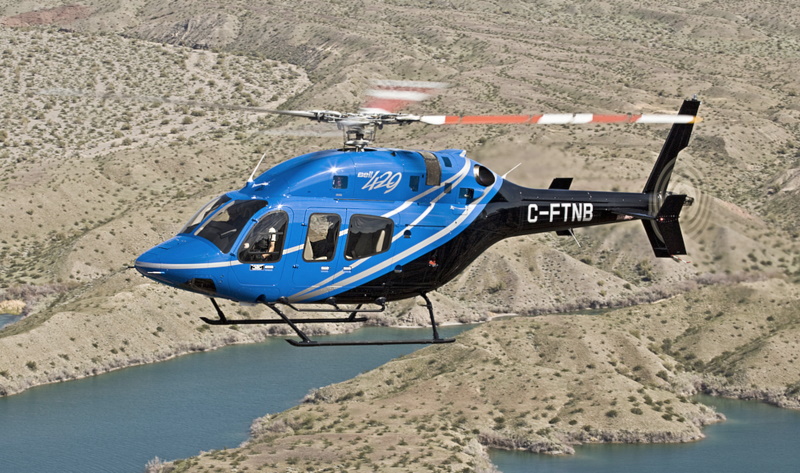
Although the Model 429's fuselage had enough resemblance to that of the Model 427 to make the two a little difficult to tell apart at first glance, the Model 429's fuselage was a completely new, modular design. Skids were standard as landing gear, but retractable wheeled landing gear was available as an option to provide an increment of improved performance. The Model 429 featured a glass cockpit with (depending on options) two or three large color MFDs, and a modular avionics scheme that simplified integration of video turrets or other gear. Incidentally, the key Model 429 recognition feature relative to the Model 427 was that the Model 429's tailfin had a "scalloped" rear edge, while the rear edge of the Model 427's tailfin was straight.
For heliliner operation, the Model 429 had three seating arrangements:
The passenger compartment could be easily reconfigured, and had a flat floor for cargo haulage when the seats were removed. There were three doors on each side, with two forward-hinged doors to the front and a rear-sliding door to the back. There was a baggage hold behind the passenger compartment.
For EMS operations, the Model 429 could handle two stretchers along with two medical attendants and two crew. The baggage compartment was replaced by rear clamshell doors, permitting easy loading of stretcher cases, a particular concern for badly injured patients; the clamshell doors hinged out and up against the fuselage, so they did not present an obstruction. Options were as per other members of the modern JetRanger line. Useful internal cargo load was 1,160 kilograms (2,560 pounds), while a sling load of up to 1,360 kilograms (3,000 pounds) could be carried externally.
___________________________________________________________________
BELL MODEL 429:
___________________________________________________________________
main rotor diameter:
10.98 meters (36 feet)
tail rotor diameter:
1.65 meters (5 feet 5 inches)
fuselage length:
11.73 meters (38 feet 6 inches)
footprint length:
13.11 meters (43 feet)
height (tailfin):
4.04 meters (13 feet 4 inches)
empty equipped weight:
2,005 kilograms (4,425 pounds)
max loaded weight (with sling load):
3,400 kilograms (7,500 pounds)
maximum cruise speed:
280 KPH (175 MPH / 150 KT)
service ceiling:
3,660 meters (12,000 feet)
range:
760 kilometers (470 MI / 410 NMI)
___________________________________________________________________
The Royal Australian Navy obtained three Model 429s in 2012, for training and utility use. They were a temporary solution, being leased, and returned in 2019, with the Airbus EC 135 taking their place.
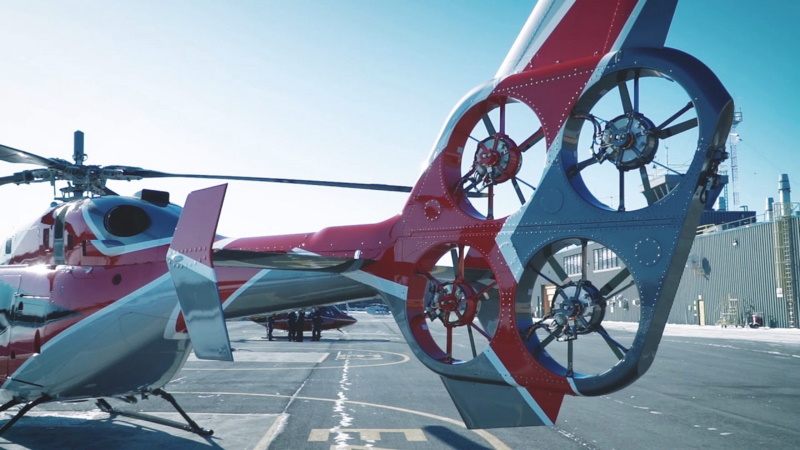
From 2020, Bell flew a specially-modified Model 429 as the "Electrically Distributed Anti-Torque (EDAT)" demonstrator, this machine featuring four small electrically-driven fans in the tailfin, replacing the tail rotor. The rationale for using the small electric fans was to reduce noise and improve safety, the helicopter tail rotor being notoriously dangerous. The electric fan scheme was also more reliable, and the small fans were more responsive to control changes than a big tail rotor.
BACK_TO_TOP* At the 2013 Paris Airshow, Bell Helicopter announced a new member of the Jetranger line, originally the "Short Light Single", but which emerged as the "Model 505 Jetranger X". It was a five-seat design -- pilot and four passengers -- of the same general configuration as earlier members of the JetRanger family, using a main / tail rotor arrangement and landing skids. It did, however, feature with an entirely new airframe, made of metal and composites, with a full-front windscreen that clearly distinguished it from earlier Jetrangers, and gave it a somewhat toylike appearance.
It did leverage off the LongRanger dynamic system, with twin-blade main and tail rotors, the tail rotor being on the left. In the initial prototype, there was a half-tailplane on the right side of the tailfin, but in production machines, there was a full tailplane under the tailboom. The rotors were driven by a single Turbomeca Arrius turboshaft, with dual-channel FADEC, engine data recorder, and power output of 375 kW (505 SHP). The Model 505 was designed to be reliable and easy to maintain.
The Model 505 had twin bucket seats in the front, plus a three-position bench seat in the back, and twin doors on each side -- the wide front door hinged on front, the narrow rear door hinged on back, with no center post to obstruct access. The rear seats could be removed for cargo haulage, with tie-downs on the floor. There was a cargo hold in the rear fuselage, with a forward-hinged door on the right.
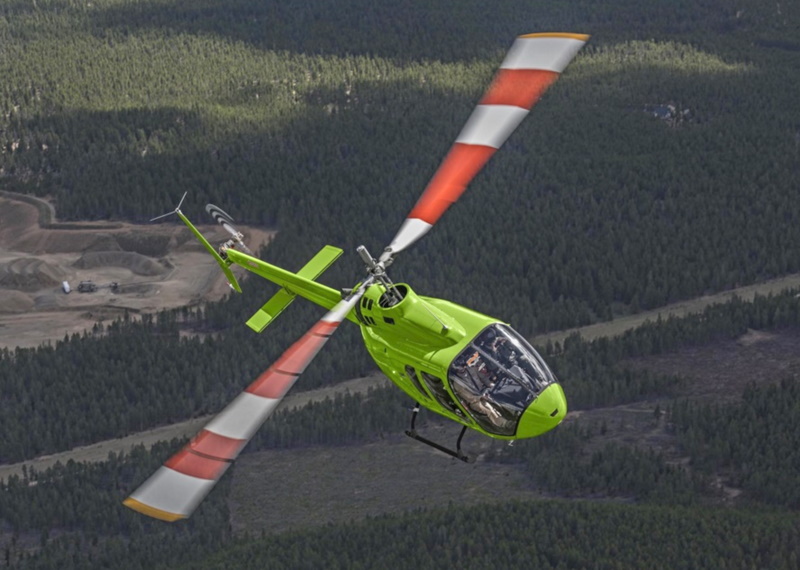
The Model 505 featured a Garmin 1000H glass cockpit, with twin wide-area color flat-panel displays; and was offered with accessories such as cable cutters, an imaging turret, or cargo sling hook. Max payload was 680 kilograms (1,500 pounds); top speed was 230 KPH (145 MPH / 125 KT), and range was 645 kilometers (400 miles / 350 NMI). Initial flight of a prototype was on 10 November 2014, with a second prototype following in early 2015.
Canadian certification was granted at the end of 2016, with customer shipments from 2017. It seems to be selling well, as a good value for a low price. In 2022, South Korea ordered a batch of 40 Model 505s for basic rotary flight training; Jordan followed later in the year, buying ten for the training role. Over 500 Model 505s have been built.
* Total production of the JetRanger series in all variants is now over 8,000 machines, and it continues to be an important helicopter in the 21st century. The list below summarizes variants in the family:
* One of the subtle confusions in the JetRanger story is that there was a Model 206 and a Model 407 in that product line, but no Model 207. Actually, there was a Bell Model 207, but it had little or nothing to do with the JetRanger.
In the early 1960s, Bell built a Model 207 prototype for a gunship helicopter, essentially providing a new forward fuselage for a Bell Model 47J Ranger piston-powered helicopter. The new fuselage featured tandem seating for pilot and gunner, as well as an undernose turret with twin M60 7.62-millimeter (0.30-caliber) machine guns. The "Sioux Scout", as the Model 207 was known, was never more than a demonstrator, and there was little or no intent to put it into production -- but it validated concepts for the extremely successful Bell AH-1 Cobra helicopter gunship.
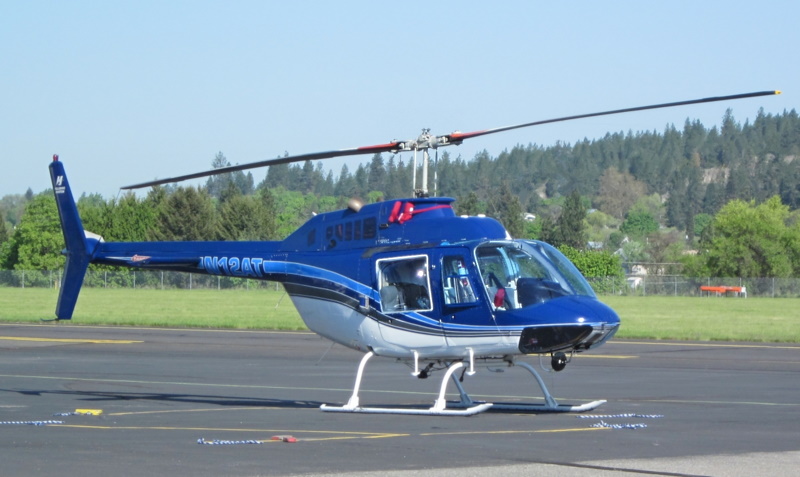
* Helicopters tend to be under-documented, and so this item turned out to be another scavenger exercise, with materials looted from various copies of JANE'S ALL THE WORLD AIRCRAFT, and such online sources as seemed halfway reliable. The Bell company website actually had some nice and reasonably detailed specifications brochures online for these machines -- surprisingly, manufacturer websites can be a weak source of information on a company's products. Other sources included:
* Illustrations credits:
* Revision history:
v1.0.0 / 01 feb 10 v1.0.1 / 01 may 10 / Review & polish. v1.0.2 / 01 jul 11 / Review & polish. v1.0.3 / 01 jun 13 / MQ-8C program details. v1.0.4 / 01 may 15 / MQ-8C first flight v1.1.0 / 01 apr 17 / Added Model 505. v1.1.1 / 01 mar 19 / Review, update, & polish. v1.2.0 / 01 feb 21 / EDAT, illustrations update. v1.3.0 / 01 dec 22 / General clean-up. v1.3.1 / 01 nov 24 / Review, update, & polish.BACK_TO_TOP
